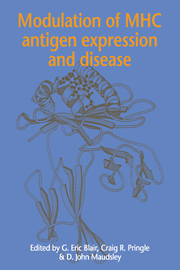Book contents
- Frontmatter
- Contents
- List of contributors
- Preface
- List of abbreviations
- 1 General introduction to the MHC
- 2 Organization of the MHC
- 3 Interactions of cytokines in the regulation of MHC class I and class II antigen expression
- 4 Control of MHC class I gene expression
- 5 Control of MHC class II gene expression
- 6 Modulation of MHC antigen expression by viruses
- 7 Modulation of MHC antigen expression by retroviruses
- 8 Modulation of MHC class I antigen expression in adenovirus infection and transformation
- 9 MHC expression in HPV-associated cervical cancer
- 10 Inhibition of the cellular response to interferon by hepatitis B virus polymerase
- 11 Cellular adhesion molecules and MHC antigens in cells infected with Epstein-Barr virus: implications for immune recognition
- 12 Effect of human cytomegalovirus infection on the expression of MHC class I antigens and adhesion molecules: potential role in immune evasion and immunopathology
- 13 Oncogenes and MHC class I expression
- 14 Mechanisms of tumour cell killing and the role of MHC antigens in experimental model systems
- 15 Manipulation of MHC antigens by gene transfection and cytokine stimulation: a possible approach for pre-selection of suitable patients for cytokine therapy
- 16 Overexpression of MHC proteins in pancreatic islets: a link between cytokines, viruses, the breach of tolerance and insulindependent diabetes mellitus?
- 17 The role of cytokines in contributing to MHC antigen expression in rheumatoid arthritis
- 18 Expression of an MHC antigen in the central nervous system: an animal model for demyelinating diseases
- Index
9 - MHC expression in HPV-associated cervical cancer
Published online by Cambridge University Press: 11 September 2009
- Frontmatter
- Contents
- List of contributors
- Preface
- List of abbreviations
- 1 General introduction to the MHC
- 2 Organization of the MHC
- 3 Interactions of cytokines in the regulation of MHC class I and class II antigen expression
- 4 Control of MHC class I gene expression
- 5 Control of MHC class II gene expression
- 6 Modulation of MHC antigen expression by viruses
- 7 Modulation of MHC antigen expression by retroviruses
- 8 Modulation of MHC class I antigen expression in adenovirus infection and transformation
- 9 MHC expression in HPV-associated cervical cancer
- 10 Inhibition of the cellular response to interferon by hepatitis B virus polymerase
- 11 Cellular adhesion molecules and MHC antigens in cells infected with Epstein-Barr virus: implications for immune recognition
- 12 Effect of human cytomegalovirus infection on the expression of MHC class I antigens and adhesion molecules: potential role in immune evasion and immunopathology
- 13 Oncogenes and MHC class I expression
- 14 Mechanisms of tumour cell killing and the role of MHC antigens in experimental model systems
- 15 Manipulation of MHC antigens by gene transfection and cytokine stimulation: a possible approach for pre-selection of suitable patients for cytokine therapy
- 16 Overexpression of MHC proteins in pancreatic islets: a link between cytokines, viruses, the breach of tolerance and insulindependent diabetes mellitus?
- 17 The role of cytokines in contributing to MHC antigen expression in rheumatoid arthritis
- 18 Expression of an MHC antigen in the central nervous system: an animal model for demyelinating diseases
- Index
Summary
Introduction
Cervical cancer and pre-cancer form a disease continuum ranging from cervical intraepithelial neoplasia (CIN) through microinvasion to invasive carcinoma; about 70% of the tumours are squamous and 30% are adeno- and adenosquamous carcinomas (Buckley & Fox, 1989). Most tumours are thought to develop from an area of intraepithelial neoplasia within the transformation zone (Coppelston & Reid, 1967). Cervical cancer is estimated to be the second most common female cancer with approximately 500 000 new cases per annum worldwide (Parkin, Laara & Muir, 1980). Sexually transmitted infections are recognized as one of the major risk factors and the active agents are thought to be specific types of human papillomavirus (HPV) (Munoz et al., 1992).
Papillomaviruses are small DNA viruses associated with benign and malignant proliferative lesions of cutaneous epithelium. Over 60 different types of papillomavirus have been described and they can be segregated into groups distinguished by DNA sequence homology and the specific lesions with which they are associated (de Villiers, 1989). HPV 6 and 11 are found most commonly in cervical condyloma, benign lesions that tend to regress spontaneously, and low-grade CIN. HPV 16 and 18 are the types most commonly associated with high-grade CIN lesions and invasive carcinoma of the cervix. The viruses will replicate only in specific differentiation stages of epithelia, which limits the use of in vitro culture methods for producing HPV. To circumvent this, molecular biological techniques have been utilized extensively to characterize HPV.
- Type
- Chapter
- Information
- Modulation of MHC Antigen Expression and Disease , pp. 233 - 250Publisher: Cambridge University PressPrint publication year: 1995
- 1
- Cited by



